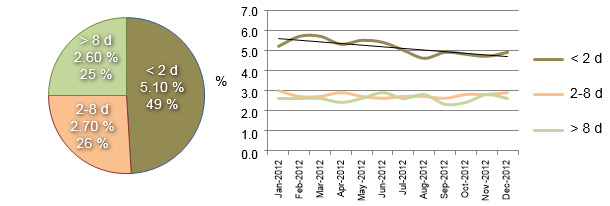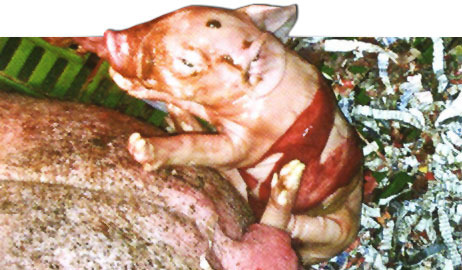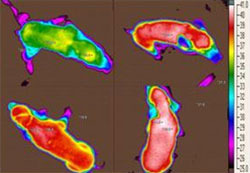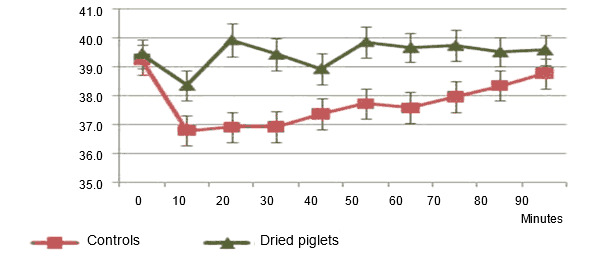In the previous article we explained the growing importance of the unevenness of the litters with the current swine genetics, whose prolificacy seems to be higher than their ability to rear their offspring. We also discussed the influence of the parity number of the sows. Next we will detail some factors that have an influence on the viability of the piglets and how to control them.
The smallest piglets with a low viability are a growing problem and they represent a high cost for the current industry, because they involve one of the main causes of pre-weaning mortality, and they have a low performance and a higher mortality in the nursery. Graph 1 shows how the mortality during lactation is distributed throughout a year.


Graph 1. Distribution of the mortality during lactation throughout year 2012. Source: Results based on 293,262 dead piglets (PigCHAMP Pro Europa's database, data from Europe and Latin America).
It is interesting to confirm that more than half of the losses happen after the third day of life, and even a 25% of them happen from the second week of age onwards. In many cases, the losses are due to the death of piglets with a low viability during the days after the farrowing. Only the losses that happen during the peripartum (< 2 d of age) tend to decrease throughout the year, whilst those between the 2nd and 8th day of life and from the second week of age onwards remain stable. There are several factors that can be connected with this tendency, and we will leave their in-depth study for later articles.
This lack of viability has a multifactorial background, and it has to be found between these two factors:
- The genetic line. Genetics are normally chosen because of other reasons, and normally they are not a modifiable thing in our daily activities. Nevertheless, we must consider the selection of genetic lines capable of passing on a higher rusticity and resistance to their offspring, and there can be considerable differences between them. Generally, the most widespread strains (LW and Pietrain) normally have a lower vitality than others not so common as Duroc or Hampshire.
- Inappropriate feeding during gestation. It is, especially during the last third of the pregnancy, a factor with an increasing importance, particularly in the systems in which the sows are group-housed, where we cannot always ensure that each sow eats a sufficient amount of feed. Checking that the sows are eating the expected amount in the feeding systems with electronic monitoring or by a visual control of the body condition in the case of manual systems must be a constant in order to avoid the risk of having litters with small piglets and an higher than desirable variation. Variation itself is capable of causing a higher mortality, besides the presence or not of low weights (Cáceres, 2001).
- On the other hand, the piglets born to primiparous sows have a lower weight at birth (Tantasuparuk et al., 2001) and at weaning (Burkey et al., 2008) than those born to multiparous sows. In the post-weaning period they are more susceptible to diseases, they consume more medications, and they have a higher mortality (Holyoake, 2006). One of the reasons is the lower concentration of IgG in the colostrum of the primiparous sows (Cabrera et al., 2012), so the risks for the piglet are even increased.
Factors regarding the peripartum:
a.- Avoid foetal stress due to intermittent or prolonged hypoxia, because it weakens the piglets hugely, making them less viable (Trujillo-Ortega, 2006). The high lactate levels generated due to this cause are highly correlated with higher mortalities. For some authors, this cause is as important as the weight at birth (Herpin, 1995), because it reduces the colostrum intake and the thermoregulation ability. We must remember that the most obvious sign of foetal stress is the presence of meconium-stained piglets (photo 1).

Photograph 1. Meconium-stained piglet, a foetal stress indicator.
b.- Avoid temperatures lower than 34 ºC for the piglet during the first days after its birth, because they will force the mobilization of its scarce energy reserves. The temperature loss is considerable after the birth, but it is much lower if we provide assistance during the farrowing and we dry the piglet (Morales, 2010).

Photograph 2. Temperature loss in a piglet not dried after its birth (green-coloured).


Graph 3. Evolution of the temperature in piglets dried or not after their birth.
This temperature loss also delays the first colostrum intake, and this feeds back negatively the energy loss situation and the lower colostrum intake by the piglet. We must also remember that the ability of the piglet to carry out gluconeogenesis is limited, and the risk that this piglets suffer hypoglycemia and die is much higher (Svendsen, 1986). These symptoms may be mistaken for infectious nervous system diseases.
Therefore, in order to improve the viability problems related with the peripartum and, especially, with the small piglets, we must:
- Induce, supervise and control carefully the length of the farrowing. We must be especially careful with the early inductions, because the gestation period is becoming longer (a bit more than a day, BD PigCHAMP Pro Europa SL) and, in general, the traditional synchronization patterns that do not bear in mind this lengthening are being maintained.
- Supervise in a special way the piglets with a higher risk:
- Small (low weight) piglets.
- Piglets born to primiparous sows.
- Piglets born at the end of the labour process.
- Separate the placenta quickly.
- Dry the piglets as they are born.
- Help the piglets to find the udder quickly and evaluate the possibility of milking and giving colostrum to the weakest piglets.
- Place at least an additional lamp on the area located at rear of the sow.
- Administer energy supplements and IgGs (generally obtained from other species).
The scientific literature regarding the viability of the small piglets suggests that, generally, the rearing of piglets that weigh less than 900 gr is not feasible, and that this is only financially viable in specialised farms with very high health and rearing/management conditions, generally with the aim of selling them as suckling piglets.
These small piglets with a lower viability are leaner when weaned and they seem to have a less active digestive system (Cranwell, 1997), so they face the nursery period with clearly disadvantageous conditions. In the next article we will explain, in depth, the expected performance from a production and health point of view.



